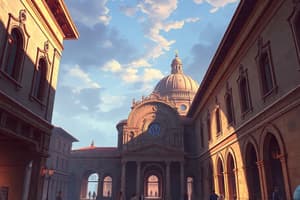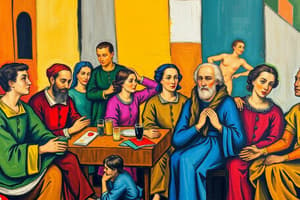Podcast
Questions and Answers
What is a characteristic of Renaissance art and architecture?
What is a characteristic of Renaissance art and architecture?
- Emphasis on dark colors and somber mood
- Rejection of classical Greek and Roman styles
- Use of abstract shapes and forms
- Classical influence from ancient Greece and Rome (correct)
What is the primary focus of humanism?
What is the primary focus of humanism?
- The potential of human beings to achieve great things through education and reason (correct)
- The importance of faith and spirituality
- The role of the state in shaping individual identity
- The significance of social hierarchy and class
Who was the founder of the Medici dynasty?
Who was the founder of the Medici dynasty?
- Pico della Mirandola
- Cosimo de' Medici (correct)
- Giovanni de' Medici
- Lorenzo de' Medici
What was one of Leonardo da Vinci's famous inventions?
What was one of Leonardo da Vinci's famous inventions?
What was a key principle of humanism?
What was a key principle of humanism?
Who was the patron of Leonardo da Vinci's famous artwork, The Last Supper?
Who was the patron of Leonardo da Vinci's famous artwork, The Last Supper?
What was a characteristic of Renaissance architecture?
What was a characteristic of Renaissance architecture?
Who was a famous humanist?
Who was a famous humanist?
What was one of Leonardo da Vinci's scientific contributions?
What was one of Leonardo da Vinci's scientific contributions?
What is the primary artistic technique used to create a soft, hazy effect in Renaissance art?
What is the primary artistic technique used to create a soft, hazy effect in Renaissance art?
Which Renaissance artist was known for his vivid colors and expressive brushstrokes?
Which Renaissance artist was known for his vivid colors and expressive brushstrokes?
What is the name of the artistic movement that reacted against classical restraint in Renaissance architecture?
What is the name of the artistic movement that reacted against classical restraint in Renaissance architecture?
What is the term used to describe the accurate depiction of nature and the human form in Renaissance art?
What is the term used to describe the accurate depiction of nature and the human form in Renaissance art?
What is the term used to describe the use of linear perspective to create depth and illusion of space in Renaissance art?
What is the term used to describe the use of linear perspective to create depth and illusion of space in Renaissance art?
Which of the following is an architectural project designed by Donato Bramante, Michelangelo, and Carlo Maderno?
Which of the following is an architectural project designed by Donato Bramante, Michelangelo, and Carlo Maderno?
What is the primary medium used in the Renaissance artistic technique of fresco?
What is the primary medium used in the Renaissance artistic technique of fresco?
Which Renaissance artistic movement is characterized by balance, harmony, and classical restraint?
Which Renaissance artistic movement is characterized by balance, harmony, and classical restraint?
What is the name of the region where Palladio's Villas were built?
What is the name of the region where Palladio's Villas were built?
Which Renaissance artistic technique involves the reproduction of images through techniques such as engraving and etching?
Which Renaissance artistic technique involves the reproduction of images through techniques such as engraving and etching?
Flashcards are hidden until you start studying
Study Notes
Art and Architecture
- Characteristics:
- Classical influence from ancient Greece and Rome
- Realism and humanism
- Use of perspective and sfumato
- Ornate and detailed decoration
- Famous artists:
- Leonardo da Vinci
- Michelangelo
- Raphael
- Titian
- Famous architectures:
- St. Peter's Basilica in Rome
- Florence Cathedral
- Palazzo Medici-Riccardi in Florence
Humanism
- Definition: a philosophical and intellectual movement that emphasizes the potential of human beings to achieve great things through education, reason, and individualism
- Key principles:
- Focus on human experience and emotions
- Revival of classical Greek and Roman texts
- Importance of education and individualism
- Influential humanists:
- Petrarch
- Boccaccio
- Pico della Mirandola
Medici Family
- A powerful and influential family in Florence during the Renaissance
- Key members:
- Cosimo de' Medici (founder of the dynasty)
- Lorenzo de' Medici (the Magnificent)
- Giovanni de' Medici (later Pope Leo X)
- Contributions:
- Patrons of the arts and architecture
- Financed the works of famous artists and thinkers
- Played a significant role in shaping Florentine politics and culture
Leonardo da Vinci
- Polymath: artist, inventor, engineer, and scientist
- Famous works:
- Mona Lisa
- The Last Supper
- Vitruvian Man
- Inventions and designs:
- Flying machines
- Armored vehicles
- Submarines
- Machines for lifting heavy weights
- Scientific contributions:
- Studies on human anatomy
- Observations on light and shadow
- Theories on flight and motion
Art and Architecture
- Characterized by classical influence from ancient Greece and Rome, realism, and humanism
- Features use of perspective and sfumato, and ornate and detailed decoration
- Famous artists include Leonardo da Vinci, Michelangelo, Raphael, and Titian
- Famous architectures include St. Peter's Basilica in Rome, Florence Cathedral, and Palazzo Medici-Riccardi in Florence
Humanism
- A philosophical and intellectual movement that emphasizes human potential through education, reason, and individualism
- Focuses on human experience and emotions, and revives classical Greek and Roman texts
- Importance of education and individualism are key principles
- Influential humanists include Petrarch, Boccaccio, and Pico della Mirandola
Medici Family
- A powerful and influential family in Florence during the Renaissance
- Key members include Cosimo de' Medici (founder), Lorenzo de' Medici (the Magnificent), and Giovanni de' Medici (later Pope Leo X)
- Contributions include patronage of arts and architecture, financing famous artists and thinkers, and shaping Florentine politics and culture
Leonardo da Vinci
- A polymath: artist, inventor, engineer, and scientist
- Famous works include Mona Lisa, The Last Supper, and Vitruvian Man
- Inventions and designs include flying machines, armored vehicles, submarines, and machines for lifting heavy weights
- Scientific contributions include studies on human anatomy, observations on light and shadow, and theories on flight and motion
Characteristics of Renaissance Art
- Renaissance art is characterized by humanism, focusing on human experience, emotions, and individualism.
- Accurate depiction of nature and the human form is a key feature of Renaissance art, known as realism.
- The art of the Renaissance is influenced by classical Greek and Roman styles and techniques.
- Linear perspective is used to create depth and illusion of space in Renaissance art.
- Sfumato is a technique used to blend colors, creating a soft, hazy effect.
Famous Renaissance Artists
- Leonardo da Vinci is a polymath and master of various art forms, including painting, sculpture, and architecture.
- Michelangelo is a sculptor, painter, and architect, known for his technical skill and emotional depth.
- Raphael is a painter and architect, known for his harmonious and balanced compositions.
- Titian is a Venetian painter, known for his vivid colors and expressive brushstrokes.
Renaissance Architectural Styles
- Classical Revival is a style characterized by the use of columns, arches, and domes, inspired by classical Greek and Roman architecture.
- Renaissance Revival is a style that blends classical elements with modern innovations.
- Mannerism is a style that reacts against classical restraint, characterized by elaborate and unconventional designs.
Famous Renaissance Architectural Works
- St. Peter's Basilica in Rome is a famous architectural work designed by Donato Bramante, Michelangelo, and Carlo Maderno.
- Florence Cathedral in Florence is a famous architectural work designed by Filippo Brunelleschi.
- Palladio's Villas in the Veneto region are famous architectural works designed by Andrea Palladio.
Renaissance Artistic Techniques
- Fresco is a technique used to paint on wet plaster, often used for large-scale murals.
- Sculpture is a technique used to carve and model materials such as marble and bronze.
- Printmaking is a technique used to reproduce images through techniques such as engraving and etching.
Renaissance Artistic Movements
- High Renaissance is characterized by balance, harmony, and classical restraint.
- Mannerism is characterized by emotional intensity, complexity, and innovative use of techniques.
- Venetian School is characterized by vivid colors, expressive brushstrokes, and a focus on light and atmosphere.
Studying That Suits You
Use AI to generate personalized quizzes and flashcards to suit your learning preferences.




